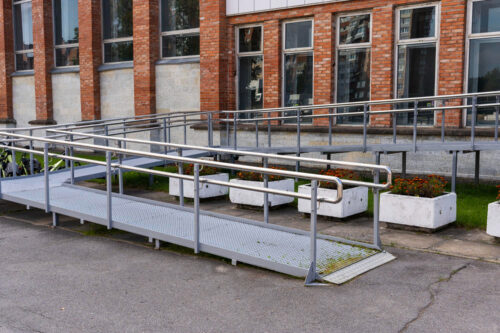Understanding Different Ramp Materials

Choosing the right material for a wheelchair ramp is crucial for ensuring long-term functionality, durability, and safety. Each material offers unique benefits and has its own set of considerations, making it essential to understand the differences before making a decision. By evaluating the characteristics of various ramp materials, we can select the one that best meets our specific accessibility needs and conditions.
Different environments and usage scenarios may require different materials. For instance, a lightweight and portable aluminium ramp may be ideal for temporary solutions, while a robust steel ramp might be better suited for high traffic areas. Traditional wood and modern composite materials also offer distinct advantages, making them suitable options for various applications. In this article, we will explore the benefits and drawbacks of the most commonly used ramp materials, helping you make an informed choice.
Understanding the properties of aluminium, steel, wood, and composite materials will guide us in selecting ramps that provide optimal safety, convenience, and longevity. Whether you need a ramp for residential use or a commercial setting, knowing the pros and cons of each material helps ensure that your investment serves its purpose effectively and efficiently.
Aluminium Ramps: Lightweight and Durable
Aluminium ramps are a popular choice for many due to their lightweight yet durable nature. These ramps are made from a material that is naturally resistant to rust and corrosion, which makes them ideal for both indoor and outdoor use. Their light weight also makes them highly portable, allowing for easy installation and relocation as needed. This is particularly beneficial for temporary accessibility solutions or for individuals who may need to move the ramp to different locations frequently.
Despite being lightweight, aluminium ramps offer impressive strength and stability. They can support considerable weight while providing a safe and sturdy surface for use. Aluminium ramps typically come with a non-slip surface, which adds an extra layer of safety, especially in wet or icy conditions. The ease of maintenance is another advantage; these ramps require minimal upkeep and can be cleaned easily, ensuring they remain in excellent condition for a long time.
Steel Ramps: Strength and Stability
Steel ramps are known for their exceptional strength and stability. These ramps are built to withstand heavy loads, making them an excellent choice for high-traffic areas and commercial settings. The robust nature of steel ensures that the ramps can endure constant use without compromising on safety or performance. Steel ramps are also highly resistant to wear and tear, which means they are likely to last for many years without needing significant repairs or replacements.
One of the standout features of steel ramps is their ability to provide a solid and stable surface. This makes them particularly suitable for applications where maximum strength and reliability are paramount. However, it is important to note that steel ramps are heavier than their aluminium counterparts, which can make them less portable. To combat rust and corrosion, steel ramps are often treated or coated, adding to their durability and longevity. With the right care, steel ramps can offer a dependable and long-lasting accessibility solution tailored to rigorous demands.
Wood Ramps: Traditional and Customizable Options
Wood ramps offer a traditional and customizable solution for those seeking an accessible entry point. These ramps can be easily modified to fit specific spaces and design preferences, making them a versatile choice for residential settings. The natural aesthetic of wood can also blend seamlessly with many home styles, enhancing the overall look of the property. Wood ramps are often chosen for their customizability, allowing for specific designs, lengths, and widths.
However, it’s important to note that wood ramps require regular maintenance to ensure safety and longevity. Treated wood can resist rot and insect damage, but periodic checks and refinishing are necessary to maintain its integrity. Non-slip surfaces or treatments are also recommended to prevent slips, especially during wet or icy conditions. With the right care, a wood ramp can provide a reliable and attractive accessibility solution.
Composite Ramps: Modern and Versatile Solutions
Composite ramps are gaining popularity due to their modern, versatile nature. Made from a combination of wood fibres and plastic, these ramps offer the best of both worlds: the look of traditional wood and the durability of synthetic materials. Composite ramps are highly resistant to weather conditions, rot, and insects, making them an excellent choice for outdoor use. They require less maintenance compared to traditional wood ramps, reducing the time and cost associated with upkeep.
Another advantage of composite ramps is their eco-friendly aspect. Many composite materials are made from recycled content, making them a sustainable choice for environmentally conscious consumers. These ramps can also be easily customized to fit various spaces and needs, similar to wood ramps, but with added durability and longevity. Composite ramps provide a durable and attractive option for accessibility, combining strength and aesthetic appeal in one practical package.
Final Thoughts
Understanding the different materials available for ramps is crucial for making an informed decision that meets accessibility needs effectively. Aluminium ramps offer lightweight durability, making them easy to install and move as needed. Steel ramps provide unparalleled strength and stability, ideal for high-traffic areas and commercial use. Wood ramps bring traditional appeal with customizable options, although they require regular maintenance to stay in good condition. Composite ramps combine modern design with minimal upkeep, offering a durable and eco-friendly solution.
Choosing the right ramp material ensures that safety, longevity, and functionality are all taken into account. Each material has unique benefits that cater to different requirements and environments. By evaluating these options, you can select the most suitable ramp for your specific situation, enhancing accessibility and convenience.
If you’re looking for expert advice on selecting the best ramp material for your needs or need assistance with installation, contact Regional Ramp today. We are here to help you find the perfect solution for your accessibility needs.
Leave a Reply

